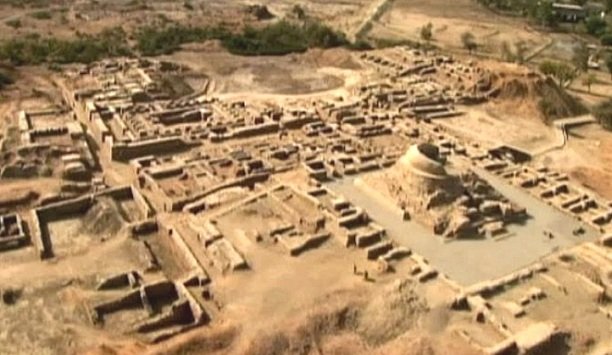Mohenjo Daro is an ancient site that is currently located in the province of Sindh in Pakistan. Researchers say that Mohenjo Daro was built around 2500 BC and it was known as one of the largest settlements that formed a part of the Indus Valley Civilization. Mohenjo Daro is a Sindhi phrase for ‘Mount of the Dead Men’. This settlement was abandoned in the 19th century BC and was only discovered in 1920. While most of these things were taught to us during our History lessons in school, here are ten interesting facts about Mohenjo Daro that you probably never heard of.
#10. Mohenjo Daro is approaching its own death. This 5000 year old city is slowly crumbling and experts believe that Mohenjo Daro will survive no more than 20 years. The remains of Mohenjo Daro have been in a state of decay and are slowly disappearing.
#9. The fall of Mohenjo Daro is one of the most mysterious things ever. Although there are many theories that talk about the destruction of this city, many published evidences talk about a massacre by armed invaders. There are also other theories that suggest that Mohenjo Daro was destroyed by an atomic bomb.
#8. Many stories by Bengali author Satyajit Ray speaks about a herd of unicorns. Satyajit also mentions various diggings in Mohenjo Daro, which include rectangular clay and various ivory seals bearing the carvings of animals such as tigers, elephants, rhinoceroses, bulls and unicorns.

#7. There are over 700 wells in the remains of Mohenjo Daro. Mohenjo Daro was called the city of drains and well by famous archaeologist Michael Jensen.
#6. Mohenjo Daro was granted world heritage status by UNESCO in 1980. This led to many more excavations and discoveries within the city; however these excavations stopped due to shortage of government funds.
#5. The excavation of the ‘Dancing Girl’ statuette is one of the rarest artifacts in the world to be excavated. This 10.8 cm long bronze statue is said to be at least 4500 years old. This statue is the impression of a girl with her hand on her hip posing in a half impudent posture. Her legs are moved slightly forward beating time and music with her feet and legs.
#4. When Pandit Jawaharlal Nehru was imprisoned in 1944, he wrote in ‘The Discovery of India’ during this time. He stated that he stood on a mound of the city of Mohenjo Daro and he was surrounded by houses and streets on all sides.
#3. The bath house of Mohenjo Daro was one of the biggest bath houses. It was 8 feet deep and approximately 23 feet wide. This public bathing pool was made of bricks and was polished with natural tar to be made waterproof. It also had a steam bath and an advanced hot air heating system. This great bath of the city of Mohenjo Daro had staircases on each side that led down to the pool. There were also small bath rooms and changing rooms that surrounded this amazing bathing pool. These surrounding rooms were used by people to clean themselves before entering the pool. This great bath was also said to be used for religious purification purposes.
#2. The city of Mohenjo Daro is said to be one of the first planned cities in the world. The city consisted of two parts. There was a higher mound called the acropolis or the citadel. There was also a lower mound that consisted of a residential area packed with houses. The city was planned with well connected wide roads, all streets that were laid in perfect pattern and some of the best designed buildings. There were various rectilinear houses that had inner courtyards and many small lanes with individual bathrooms and drains. These drains were covered and ran into a complex underground sewer system. The city also featured a market place, towers, underground furnace and a few defense fortifications. One interesting thing to note is the absence of temples, palaces, and tombs. There were no traces of a king, queen or a government either.
#1. Mohenjo Daro was originally named ‘Kukkutarma’. While not many scholars were able to decipher the Harappan script, it is speculated that this city may have been named ‘Kukkutarma’. This was the Dravidian name that meant ‘the city of cockerels’. This name was based on a seal discovered from the site. It was also found that domesticated chickens were bred for various religious purposes, cock fighting and for sacrifices as well.
Santosh Kumar is a Professional SEO and Blogger, With the help of this blog he is trying to share top 10 lists, facts, entertainment news from India and all around the world.
